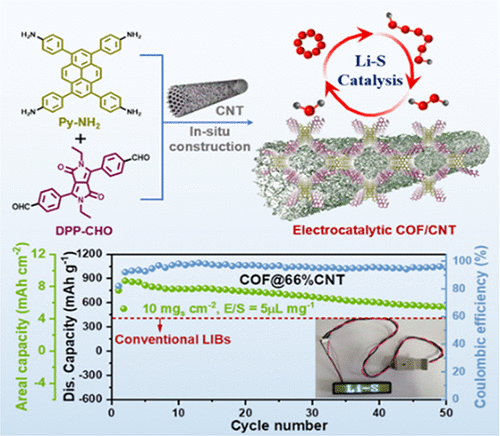当前位置:
X-MOL 学术
›
ACS Energy Lett.
›
论文详情
Our official English website, www.x-mol.net, welcomes your
feedback! (Note: you will need to create a separate account there.)
A Highly Conductive COF@CNT Electrocatalyst Boosting Polysulfide Conversion for Li–S Chemistry
ACS Energy Letters ( IF 19.3 ) Pub Date : 2021-08-11 , DOI: 10.1021/acsenergylett.1c00943 Jie Xu 1, 2 , Weiqiang Tang 3 , Chao Yang 4 , Ingo Manke 4 , Nan Chen 5 , Feili Lai 6 , Ting Xu 1 , Shuhao An 1 , Honglai Liu 1 , Zhiliang Zhang 3 , Yongjie Cao 2 , Nan Wang 2 , Shuangliang Zhao 3, 7 , Dongfang Niu 3 , Renjie Chen 5
ACS Energy Letters ( IF 19.3 ) Pub Date : 2021-08-11 , DOI: 10.1021/acsenergylett.1c00943 Jie Xu 1, 2 , Weiqiang Tang 3 , Chao Yang 4 , Ingo Manke 4 , Nan Chen 5 , Feili Lai 6 , Ting Xu 1 , Shuhao An 1 , Honglai Liu 1 , Zhiliang Zhang 3 , Yongjie Cao 2 , Nan Wang 2 , Shuangliang Zhao 3, 7 , Dongfang Niu 3 , Renjie Chen 5
Affiliation

|
The catalysis of covalent organic frameworks (COFs) in Li–S chemistry is largely blocked by a weak chemical interaction and low conductivity. Herein, a new kind of diketopyrrolopyrrole (DPP)-based COF is in situ fabricated onto the carbon nanotube (CNT) surface (denoted as COF@CNT) to uncover the electrocatalysis behavior by its strong chemical interaction and highly conductive property. We declare that the electrocatalytic activity of DPP-COF can be maximized by introducing an appropriate content of CNT (66 wt %); the analyses including density functional theory calculations, X-ray photoelectron spectroscopy, Fourier transform infrared, and Raman show that the DPP moiety can mediate the conversion of polysulfides contributed by a C═O/C–O bonding conversion. Hence, the modified battery shows a 0.042% decay rate over 1000 cycles and achieves a desirable capacity of 8.7 mAh cm–2 with 10 mg cm–2 sulfur loading and lean electrolyte (E/S = 5). This work will inspire the rational design of COF@support hybrids for various electrocatalysis applications.
更新日期:2021-09-10


















































 京公网安备 11010802027423号
京公网安备 11010802027423号